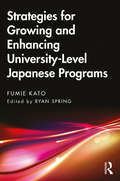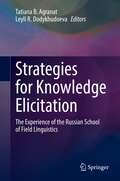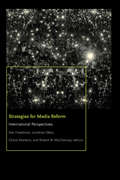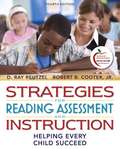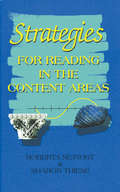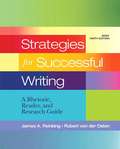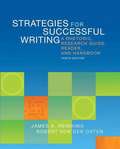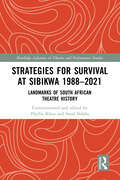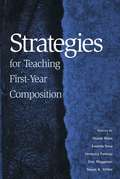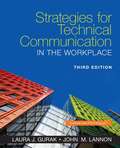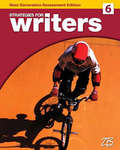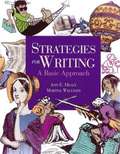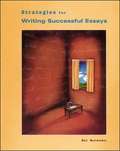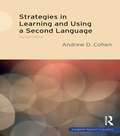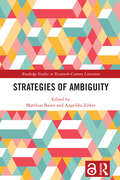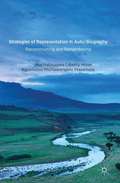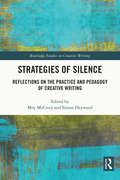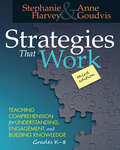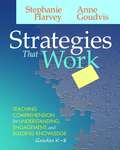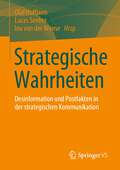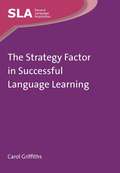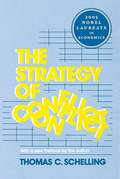- Table View
- List View
Strategies for Growing and Enhancing University-Level Japanese Programs
by Fumie KatoStrategies for Growing and Enhancing University-Level Japanese Programs offers foreign language program managers and directors, as well as teachers of less commonly taught languages, the insights and proven practical actions they can take to enhance and grow their language programs. Using the Japanese program at UNC Charlotte as the primary case study, author Fumie Kato provides step-by-step instructions on how she grew the Japanese program there from 133 students per semester in 2002 to 515 students per semester in 2017; from a program with just one full-time professor and one part-time faculty member, to a faculty of seven full-time and three part-time members. While Japanese is the example used in the book, the principles can be applied by anyone managing foreign language/less commonly taught language programs who wishes to expand their program and raise their students’ success rates. The book is therefore of interest to instructors, coordinators and directors of foreign language education programs throughout the world.
Strategies for Knowledge Elicitation: The Experience of the Russian School of Field Linguistics
by Tatiana B. Agranat Leyli R. DodykhudoevaThis volume provides an overview of experimental methods, approaches, and techniques used by field linguists of the Russian school, and highlights the fieldwork experience of Russian scholars working in regions with a range of languages that differ genetically, typologically, and in the degree of their preservation.The collection presents language and sociolinguistic data relating to fieldwork in diverse languages: Uralic, Altaic, Paleo-Siberian, Yeniseian, Indo-European Iranian, Vietic, Kra-Day, and Mayan languages, as well as pidgin.The authors highlight the fieldwork techniques they use, and the principles underlying them.The volume’s multidisciplinary approach covers linguistic, ethnolinguistic, sociolinguistic, educational, and ethnocultural issues. The authors explore problems associated with the study of minority languages and indicate diverse and creative techniques for data elicitation. Close collaboration with speakers lies at the core of their approach. The collection presents strategies for eliciting systems of knowledge from mother-tongue speakers, triggering linguistic self-awareness, and providing semantic and morphosyntactic context for their languages.This publication is intended for academics, and for specialists in the field of linguistics and minority and indigenous languages. It will also benefit students as a guide to field research, as well as language activists, interested in documenting and preserving their mother tongue.
Strategies for Media Reform: International Perspectives (Donald McGannon Communication Research Center's Everett C. Parker Book Series)
by Jonathan A. Obar Cheryl Martens Robert W. McChesneyMedia reform plays an increasingly important role in the struggle for social justice. As battles are fought over the future of investigative journalism, media ownership, spectrum management, speech rights, broadband access, network neutrality, the surveillance apparatus, and digital literacy, what effective strategies can be used in the pursuit of effective media reform?Prepared by thirty-three scholars and activists from more than twenty-five countries, Strategies for Media Reform focuses on theorizing media democratization and evaluating specific projects for media reform. This edited collection of articles offers readers the opportunity to reflect on the prospects for and challenges facing campaigns for media reform and gathers significant examples of theory, advocacy, and activism from multinational perspectives.
Strategies for Reading Assessment and Instruction: Helping Every Child Succeed (4th Edition)
by D. Ray Reutzel Robert B. CooterThis best-selling book is a ready-reference for teachers of reading, a highly popular core text for reading diagnosis and assessment courses, and an ideal guide for ongoing professional development workshops. The unique format of the book, with its IF/THEN Strategy Guides that help readers quickly match student needs to research-proven strategies, make it a quick, effective, "point-of-teaching" resource of up to date information, strategies, and suggestions. In Strategies for Reading Assessment and Instruction Readers can quickly turn to current information on evidence-based assessment and instruction and find ways to assess, teach, and organize for effective and comprehensive reading instruction.
Strategies for Reading in the Content Areas
by Roberta L. Sejnost Sharon M. ThieseFormerly a SkyLight publication.Strategies for Reading in the Content Areas-excerpted from Reading and Writing Across Content Areas-describes the reading process and suggests strategies that can be used before, during, and after reading. Teachers will find examples for science, social studies, mathematics, and health. This handy booklet is a great, easy-to-access resource for content area teachers!
Strategies for Second Language Listening: Current Scenarios and Improved Pedagogy
by Denise Santos Suzanne GrahamThis book seeks to help teachers teach listening in a more principled way by presenting what is known from research, exploring teachers' beliefs and practices, examining textbook materials, and offering practical activities for improving second language listening.
Strategies for Successful Writing: A Rhetoric, Research Guide, and Reader (Brief Edition, 9th Edition)
by James A. Reinking Robert von der OstenThe ninth edition of Strategies for Successful Writing: A Rhetoric, Research Guide, and Reader is a comprehensive textbook that offers ample material for a full-year composition course.
Strategies for Successful Writing: A Rhetoric, Research Guide, Reader, and Handbook (Tenth Edition)
by James A. Reinking Robert von der OstenStrategies for Successful Writing keeps instruction brief and to-the-point so that students spend less time reading about writing and more time writing. Instruction delivered through extensive examples helps students see what different strategies look like when applied in real texts.
Strategies for Survival at SIBIKWA 1988 – 2021: Landmarks of South African Theatre History (Routledge Advances in Theatre & Performance Studies)
by Phyllis Klotz Smal NdabaThis book provides an engaging and contextualised insight into a South African township-based arts centre that has survived the vicissitudes of steady militarisation in townships during some of the worst years of apartheid as well as the exhilaration of a new democratic policy while attempting to circumnavigate different policies and funding dispensations. Sibikwa provides arts centres across the world and especially those in decolonising countries with strategies for survival in tumultuous times. This multi-disciplinary book maps and co-ordinates wider historical, political, and social contextual concerns and events with matters specific to a community-based east of Johannesburg and provides an exploration and analysis by experts of authentic theatre-making and performance, dance, indigenous music, arts in education and NGO governance. It has contemporary significance and raises important questions regarding inclusivity and transformation, the function and future of arts centres, community-based applied arts practices, creativity, and international partnerships. This study will be of great interest to students and scholars in theatre and performance, indigenous music, dance, and South African history.
Strategies for Teaching First-Year Composition
by Duane Roen Veronica Pantoja Lauren Yena Susan K. Miller Eric WaggonerThis book presents 93 essays that offer guidance, reassurance, and commentary on the many activities leading up to and surrounding classroom instruction in first-year composition. Essays in the book are written by instructors who teach in community colleges, liberal arts colleges, state university systems, and research institutions.
Strategies For Technical Communication In The Workplace (Third Edition)
by Laura J. Gurak John M. LannonBased on the acclaimed Technical Communication by Lannon and Gurak, Strategies for Technical Communication in the Workplace, Third Edition prepares students for workplace writing through a clear and concise writing style, useful checklists, practical applications, numerous sample documents, and coverage of technology and global issues. <P><P>The third edition addresses changing technology in the workplace with a complete chapter on social media, updated examples, and sample documents. This brief and affordable text is accessible to students of all writing levels.
Strategies for Writers (6th grade) (Next Generation Assessment Edition)
by L. Crawford Rebecca Bowers Sipe"Features a rubrics-based instruction and a writing process with emphasis on prewriting and revising. Grammar is taught in conjunction with writing, so students learn how grammar is best applied to writing." (teacher's edition p.T2).
Strategies for Writing: A Basic Approach
by Ann E. Healy Martha WalusayiA composition textbook illustrated and written with a lot of model essays, an introduction to writing resumes and cover letters, numerous individual and small-group exercises throughout the text to make the reader become a more flexible writer.
Strategies for Writing Successful Essays
by Nell MeriwetherA quick and easy to use guide to writing an essay.
Strategies in Learning and Using a Second Language (Applied Linguistics And Language Study Ser.)
by Andrew D. CohenStrategies in Learning and Using a Second Language examines what it takes to achieve long-term success in languages beyond the first language. Distinguishing language learning from language-use strategies, Andrew D. Cohen disentangles a morass of terminology to help the reader see what language strategies are and how they can enhance performance. Particular areas of research examined in the book include: - links between the use of task-specific strategies and language performance - how multilinguals verbalise their thoughts during language learning and use strategies that learners use in test-taking contexts In this fully revised and substantially rewritten second edition, every chapter has been reworked, with material either updated or replaced. Entirely new material has also been developed based on examples of specific strategies supplied by actual learners, mostly drawn from a website featuring these strategies in the learning of Spanish grammar.Strategies in Learning and Using a Second language will be an invaluable resource for language teachers and researchers, as well as for administrators of second language programmes and for students of applied linguistics.
Strategies of Ambiguity (Routledge Studies in Twentieth-Century Literature)
by Matthias Bauer Angelika ZirkerThere has been a growing awareness that ambiguity is not just a necessary evil of the language system resulting, for instance, from its need for economy, or, by contrast, a blessing that allows writers to involve readers in endless games of assigning meaning to a literary text. The present volume contributes to overcoming this alternative by focusing on strategies of ambiguity (and the strategic avoidance of ambiguity) both at the production and the reception end of communication. The authors examine ways in which speakers and hearers may use ambiguous words, structures, references, and situations to pursue communicative ends. For example, the question is asked what it actually means when a listener strategically perceives ambiguity, which may happen both synchronically (e.g. in conversations) as well as diachronically (e.g. when strategically ambiguating biblical texts in order to make them applicable to moral lessons). Another example is the question whether ambiguity awareness increases the strategic use of ambiguity in prosody. Moreover, the authors not only enquire into effects of ambiguous meanings but also into the strategic use of ambiguity as such, for example, as a response to censorship or as a means of provoking irritation. This volume brings together several contributions from linguistics, literary studies, rhetoric, psychology and theology, and aims at providing a systematic approach to the strategic production and perception of ambiguity in a variety of texts and contexts. The Open Access version of this book, available at http://www.taylorfrancis.com, has been made available under a Creative Commons Attribution-Non Commercial-No Derivatives 4.0 license.
Strategies of Ambiguity (Routledge Studies in Twentieth-Century Literature)
by Matthias Bauer Angelika ZirkerThere has been a growing awareness that ambiguity is not just a necessary evil of the language system resulting, for instance, from its need for economy or, by contrast, a blessing that allows writers to involve readers in endless games of assigning meaning to a literary text. The present volume contributes to overcoming this alternative by focusing on strategies of ambiguity (and the strategic avoidance of ambiguity) both at the production and the reception end of communication. The authors examine ways in which speakers and hearers may use ambiguous words, structures, references, and situations to pursue communicative ends. For example, the question is asked what it actually means when a listener strategically perceives ambiguity, which may happen both synchronically (e.g. in conversations) as well as diachronically (e.g. when strategically ambiguating biblical texts in order to make them applicable to moral lessons). Another example is the question of whether ambiguity awareness increases the strategic use of ambiguity in prosody. Moreover, the authors enquire not only into the effects of ambiguous meanings but also into the strategic use of ambiguity as such, for example, as a response to censorship or as a means of provoking irritation. This volume brings together several contributions from linguistics, literary studies, rhetoric, psychology, and theology, and it aims to provide a systematic approach to the strategic production and perception of ambiguity in a variety of texts and contexts.The Open Access version of this book, available at http://www.taylorfrancis.com, has been made available under a Creative Commons Attribution-Non Commercial-No Derivatives 4.0 license.
Strategies of Representation in Auto/biography
by Muchativugwa Hove Kgomotso MasemolaStrategies of Representation in Auto/biography investigates how selves are represented and reconstructed in selected auto/biographical readings from African literary discourse. It examines how such representations confirm, validate, interrogate and pervade conversations with issues of identity, nation and history. In addition to providing an overview of the multidimensionality of auto/biography, the book also introduces readers to various ways of reading and analysing auto/biographical writings and develops specific perspectives on the genre and views inherently expressed through the re-imagined, re-membered and re-constructed self that speaks through the pages of autobiographical scripting. The focus on auto/biographical writings from southern Africa, specifically South Africa and Zimbabwe, offers a fresh reading of the work of significant figures in the political, economic and sociological spheres of these nation states. This collection shows that auto/biography may be more than simply the representation of an individual life, and that the socio-cultural memory of a people is a core aspect influencing individual self-representation.
Strategies of Silence: Reflections on the Practice and Pedagogy of Creative Writing (Routledge Studies in Creative Writing)
by Simon Heywood Moy McCroryThis unique book takes silence as its central concept and questions the range of meanings and values which inform the idea as it impinges on the creative process and its content and contexts. The thematic core of silence allows a consideration of silencing and silence as opposite ends of a spectrum: one shutting down, the other enabling and opening up. As a multidisciplinary collection of essays derived from the teaching and implementation of Creative Writing at university level, the contributors consider silence as strategic, both through the need for silence and as something which compels resistance. They explore how writing has employed images and tropes of silence in the past, and used silence and gaps technically. In considering marginalised and forgotten voices, this book shows how writers bring their diverse range of backgrounds and experience to work with and against silence in Creative Writing Studies. The first theoretical work on silence in Creative Writing, this field-shifting book is an essential read for both practitioners and students of Creative Writing at the higher education level.
Strategies That Work: Teaching Comprehension for Engagement, Understanding, and Building Knowledge, Grades K-8
by Stephanie Harvey Anne GoudvisSince the first publication of Strategies That Work , numerous new books on reading comprehension have been published and more educators than ever are teaching comprehension. In this third edition of their groundbreaking book, authors Stephanie Harvey and Anne Goudvis bring you Strategies That Work: Teaching Comprehension for Understanding, Engagement, and Building Knowledge. This new edition is organized around three section: Part I: Starting with the Foundation of Meaning, these chapters provide readers with a solid introduction to reading comprehension instruction, including principles that guide practice, suggestions for text selection, and a review of recent research Part II: Part II contains lessons to put these principles into practices for all areas of reading comprehension Part III: This section shows you how to integrate comprehension instruction across the curriculum and the school day, with a focus on science and social studies. In addition, this new version includes updated bibliographies, including the popular Great Books for Teaching Content, online resources, and fully revised chapters focusing on digital reading, strategies for integrating comprehension and technology, and comprehension across the curriculum. Harvey and Goudvis tackle close reading, close listening, text complexity, and critical thinking and demonstrate how your students can build knowledge through thinking-intensive reading and learning. This third edition is a must-have resource for a generation of new teachers – and a welcome refresher for those with dog-eared copies of this timeless guide to reading comprehension.
Strategies That Work: Teaching Comprehension for Understanding, Engagement, and Building Knowledge
by Stephanie Harvey; Anne GoudvisStrategies That Work, more than a million teachers have benefited from Steph and Anne's practical advice on creating classrooms that are incubators for deep thought. This third edition is a must-have resource for a generation of new teachers--and a welcome refresher for those with dog-eared copies of this timeless guide to teaching comprehension.
Strategies to Achieve Reading Success (Star Series #F)
by Curriculum AssociatesStrategies to Achieve Reading Success Star Series F
Strategische Wahrheiten: Desinformation und Postfakten in der strategischen Kommunikation
by Olaf Hoffjann Lucas Seeber Ina von der WenseStrategische Kommunikation zielt mit ihren kontingenten Wirklichkeitsbeschreibungen seit jeher auf gesellschaftliche Wahrheitsmodelle. Wie häufig gesellschaftliche Wahrheitsmodelle auf strategische Kommunikationsbemühungen zurückgehen, auf Unwahrhaftigkeit beruhen und damit zumindest zeitweise zu strategischen Wahrheiten werden, zeigen eindrucksvoll zwischenzeitlich geglaubte Wahrheiten, die sich als Lüge entpuppt haben: von Walter Ulbrichts „Niemand hat die Absicht, eine Mauer zu errichten“ über Hitlers Tagebücher bis hin zu den Massenvernichtungswaffen im Irak. Die erfolgreichen Kampagnen der Brexiteers und von Donald Trump 2016 haben diesem Thema zu neuer und bislang ungeahnter Aufmerksamkeit verholfen. Während die Themen Desinformation und postfaktische Gesellschaft die Journalismus-, politische Kommunikations- und Medienethikforschung aktuell zu dominieren scheinen, ist das Schweigen der deutschsprachigen und internationalen PR- und Organisationskommunikationsforschung auffällig. Dies ist umso bemerkenswerter, weil die PR-Wissenschaft in der Vergangenheit immer wieder versucht hat, ihren Gegenstand zu schärfen, indem sie sich am Begriff der Propaganda abgearbeitet hat. Daraus müsste eigentlich eine Affinität für das Thema Desinformation resultieren. Aber genau das Gegenteil ist offensichtlich der Fall: Hat sich die PR-Wissenschaft gerade deshalb nicht mit Desinformation beschäftigt, weil sie sich so dezidiert von Propaganda und darin eingeschlossenen desinformierenden und manipulativen Techniken abgrenzen will? Was sind die Gründe hierfür? Glauben wir, bereits alles zum Thema gesagt zu haben? Liegt dies daran, dass sich die PR- und Organisationskommunikationsforschung seit jeher vor allem für Unternehmen und weniger für politische und Non-Profit-Organisationen interessiert? Oder fühlen wir uns hier schlicht und ergreifend nicht zuständig? Es scheint offenkundig höchste Zeit zu sein, sich wieder eingehend mit Fragen der Desinformation aus der Perspektive der strategischen Kommunikationsforschung zu befassen. Die Beiträge des Tagungsbandes fokussieren hierzu auf neue theoretische Perspektiven, normative Bewertungen und empirische Befunde.
The Strategy Factor in Successful Language Learning
by Carol GriffithsThis book addresses fundamental questions regarding the relationships between successful language learning and strategy use and development according to learner, situational or target variables. It considers strategy effectiveness from an individual point of view and discusses pedagogical issues, especially relating to teacher perceptions and training, classroom and learner factors, methodology and content. The book begins by discussing underlying theoretical issues and then presents evidence from empirical studies; in addition to presenting a quantitative view, the book also takes a qualitative look at strategy use by individuals. Rather than focusing on strategies divorced from the 'real world' of the classroom, this book explores the issues from the teaching/learning point of view.
The Strategy of Conflict
by Thomas C. SchellingThe text opens to rational analysis a crucial field of politics, the international politics of threat, or as the current term goes, of deterrence.
